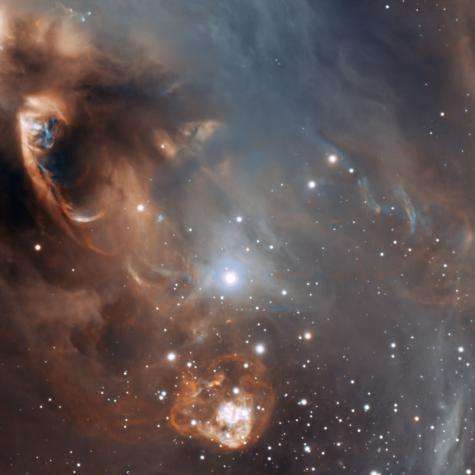The drama of starbirth (w/ video)

(PhysOrg.com) -- A new image from ESO's Very Large Telescope gives a close-up view of the dramatic effects newborn stars have on the gas and dust from which they formed. Although the stars themselves are not visible, material they have ejected is colliding with the surrounding gas and dust clouds and creating a surreal landscape of glowing arcs, blobs and streaks.
The star-forming region NGC 6729 is part of one of the closest stellar nurseries to the Earth and hence one of the best studied. This new image from ESO's Very Large Telescope gives a close-up view of a section of this strange and fascinating region. The data were selected from the ESO archive by Sergey Stepanenko as part of the Hidden Treasures competition. Sergey's picture of NGC 6729 was ranked third in the competition.
Stars form deep within molecular clouds and the earliest stages of their development cannot be seen in visible-light telescopes because of obscuration by dust. In this image there are very young stars at the upper left of the picture. Although they cannot be seen directly, the havoc that they have wreaked on their surroundings dominates the picture. High-speed jets of material that travel away from the baby stars at velocities as high as one million kilometres per hour are slamming into the surrounding gas and creating shock waves. These shocks cause the gas to shine and create the strangely coloured glowing arcs and blobs known as Herbig-Haro objects.
In this view the Herbig-Haro objects form two lines marking out the probable directions of ejected material. One stretches from the upper left to the lower centre, ending in the bright, circular group of glowing blobs and arcs at the lower centre. The other starts near the left upper edge of the picture and extends towards the centre right. The peculiar scimitar-shaped bright feature at the upper left is probably mostly due to starlight being reflected from dust and is not a Herbig-Haro object.
This enhanced-colour picture was created from images taken using the FORS1 instrument on ESO's Very Large Telescope. Images were taken through two different filters that isolate the light coming from glowing hydrogen (shown as orange) and glowing ionised sulphur (shown as blue). The different colours in different parts of this violent star formation region reflect different conditions -- for example where ionised sulphur is glowing brightly (blue features) the velocities of the colliding material are relatively low -- and help astronomers to unravel what is going on in this dramatic scene.
Provided by ESO




















